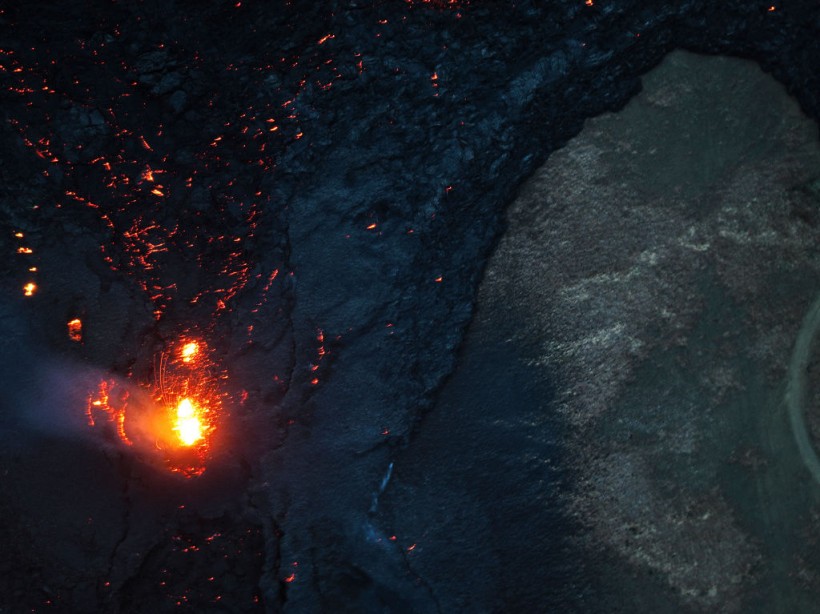In southwest Iceland, a volcano has erupted unexpectedly for the fourth time in four months, creating extensive fiery fissures. The eruption expelled molten lava, narrowly avoiding Grindavík. While the event currently poses no immediate threat to locals, experts caution that if the lava reaches the sea, it could produce a significant toxic gas plume hazardous to coastal residents.
Ongoing volcanic activity, with smoke and vivid orange lava, persisted on Monday following Saturday's eruption, though nearby infrastructure and the fishing town remain unaffected.

(Photo : HALLDOR KOLBEINS/AFP via Getty Images)
Iceland's Most Powerful Volcanic Eruption To Date
The volcano, stretching about 9 miles (15 kilometers) underground, forms a magma tunnel beneath southwest Iceland, extending from Grindavík to Sundhnúk in the Reykjanes Peninsula.
As the concealed magma nears the surface, it breaches, resulting in long and narrow fissures that forcefully expel lava, ash, and smoke. Although the intense activity is brief, the resulting lava can travel several miles, consuming anything in its path before cooling down.
This recent eruption, the fourth occurrence since December, occurred suddenly on March 16, producing lava from three separate points and creating two fissures between Hagafell and Stóra-Skógfell.
According to the Icelandic Met Office (IMO), the largest fissure, around 1.8 miles (2.9 km) in length, matches the size of the previous eruption. Magnús Tumi Guðmundsson, a geophysics professor at the University of Iceland, described this eruption as the volcano's "most powerful" to date.
Despite ongoing activity, the rate of magma release has decreased to between 2% and 5% of the original output. While the lava from the smaller fissure initially approached within 1,000 feet (300 meters) of Grindavík's defenses, it is now shifting towards the coast.
This situation poses potential hazards if the lava reaches the shoreline, as rapid cooling of the molten rock could release hydrochloric acid gas, which can cause severe injuries or death.
Although the town of Grindavík lies within the potential danger zone of the toxic gas, most residents have been evacuated, and those remaining have been cautioned to stay away.
As of Sunday, March 17, the lava flow was only about 2,000 feet (600 meters) from the coast but is expected to draw closer by the end of Monday, March 18, albeit at a reduced pace. Authorities remain vigilant, prepared for any scenario as the situation continues to unfold.
READ ALSO: Iceland Volcano Erupts After Weeks of Heightened Seismic Activity, Forcing Thousands To Flee
Is It Safe To Travel to Iceland This Time?
Despite concerns regarding its impact on travel, Keflavik Airport nearby remains operational. ISAVIA, the Icelandic airport operator, advises travelers to stay informed about flight updates.
While volcanic eruptions typically pose air travel hazards due to airborne ash particles, the recent eruption on the Reykjanes Peninsula is not expected to discharge significant amounts of ash. Reykjavik, the capital city, and the rest of Iceland remain unaffected by the eruptions.
Although the eruption site has been closed until further notice, travel advisories for Iceland have not been issued. Visitors are encouraged to avoid the vicinity of the eruption and adhere to guidance from local authorities. There have been no travel bans from countries, allowing airlines and tour operators to continue operating as usual, and cancellations may not automatically qualify for refunds.
RELATED ARTICLE: Iceland Volcano 3rd Eruption in 3 Months: Lava Shoots Into the Air; Subsurface Magma Flows at Unprecedented Speed
Check out more news and information on Volcanic Eruption in Science Times.




![Earth's Quasi-Moon Kamo‘oalewa Could Originate From Lunar Surface Not Asteroid Belt [Study]](https://1721181113.rsc.cdn77.org/data/thumbs/full/53275/89/56/50/40/earths-quasi-moon-kamo-oalewa-could-originate-from-lunar-surface-not-asteroid-belt-study.png)









